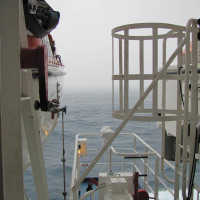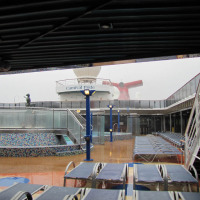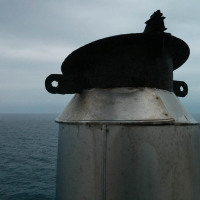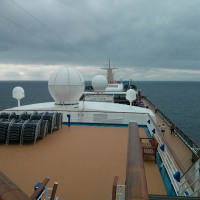When we woke up on Tuesday, the ship was somewhere off the North Carolina coast, and by noon we were passing off Cape Hatteras. The seas had become a bit choppy, though not too bad, and there was a fog and drizzly rain reducing visibility. I understand this is related to the storm system that caused some rain and freezing rain further north. Because of the conditions, we were unable to see the land . . . or much of the ocean, for that matter.
We grabbed some breakfast at the buffet, and Melissa went to the spa. I went back to the room to work on updating my blog notes and then went out taking some photos around the ship. In the evening, it was the first formal night so we dressed up and had our pictures taken.
On Wednesday, the weather was much nicer. There was some sun, the seas were calm, and the temperatures were rising. We slept in, had a light late breakfast, walked around above-deck, and got some outside photos. For much of the day we were off the coast of Georgia.
We really didn’t do much either day. Part of why we chose a cruise with several at-sea days is because we like to relax and do nothing on our vacations (at least for part of the time).
The Papal Retirement
Of course, I didn’t get off quite so easy. It is fast becoming a tradition that whenever we go on a cruise, some major, newsworthy event occurs. Usually, it ends up being something that affects us personally somehow. For example, on our first cruise in 2005—our honeymoon—we found out that Apple had announced its switch to the Intel chip platform, which threw my plans for buying a notebook into upheaval. Of course, being a techie, I wanted all kinds of details . . . and all I could get was a short New York Times article (not my go-to source for accurate news), which was republished in the shipboard daily news bulletin, and some limited, non-technical coverage on CNN.
But that pales in comparison to the announcement on Monday that Pope Benedict XVI will be retiring at the end of the month due to ill health. Apple has made major computing platform and operating system switches quite a few times in the last thirty years—from Apple II to Macintosh, from Motorola 68k to PowerPC, from Mac OS Classic to Mac OS X, from PowerPC to Intel, and (dare I say it?) from Mac OS X and Intel to iOS and ARM. Popes, on the other hand, don’t retire very often. The last one to do it was Pope Gregory XII. He retired in the year 1415.
It was big news when Pope John Paul II died in 2005, and when then-Cardinal Joseph Ratzinger ascended to become the Bishop of Rome, but we were members of the United Methodist Church at the time and watched the proceedings as bemused (though respectful) outsiders. When Melissa and I were welcomed into full communion with the Catholic Church in 2009, Pope Benedict XVI had already held the papacy for about four years. So although Pope John Paul II was a major figure on the world stage for much of our lives, Pope Benedict XVI is the only pope we’ve ever had as Catholics in full communion.
So for the first time, Melissa and I will be experiencing a papal conclave and transition as Catholics. Although everybody will be experiencing this particular type of transition for the first time, since the last time we had a conclave while the last pope was still alive was—as I mentioned—six hundred years ago. I’m sure a lot of Vatican librarians are dusting off a lot of fifteenth century documents about what to do with a retired pope. Regardless, it will be an exciting and unusual time for the church and all her people.
I didn’t expect to be blogging about a retiring Holy Father when we set off from Baltimore, that’s for sure.
Wireless Data Connectivity
The good news is that I have better news sources at my fingertips, and the ability to post to Facebook and Off on a Tangent from the ship. The television still doesn’t show much more than CNN, but for the first time Melissa and I made arrangements for limited Internet access on the cruise.
Most cruise ships have a couple of connectivity options. There is a wifi signal throughout the ship, but it’s not very easy to use on a mobile device, it’s quite pricey, it’s billed by-the-minute, and it doesn’t work at all (obviously) when you’re not on the ship. There is also cell phone signal available through ‘Cellular at Sea,’ but the U.S. wireless carriers charge you an absolute fortune for international roaming. The advantage to international roaming is that it will work on the ship and the shore (in theory; more on that shortly).
Since Melissa and I use unlocked GSM phones, we found that the most affordable course of action was to purchase two travel SIM cards from iPhoneTrip.com. Each ‘World’ card came with fifty megabytes of data per day (provided via Vodafone Germany), and we expected they would work both on the ship and in the ports we were visiting. The total cost for the two SIMs with a week’s worth of access was only $150, compared to the same price for only eight hours on wifi (on just one device at a time), and more than twice as much for international roaming on an American phone network. It’s still not cheap, but it’s an up-front cost that we could budget in with the price of the cruise, and we don’t have to worry about overages or anything like that (data will just cut-off if we go over the limit, and then turn back on the following day).
Unfortunately the data connectivity on the ship is dog-slow, and would periodically cut-out entirely. It’s no worse than it would be with international roaming or the on-board wifi, since they all go through the same pipe, but it’s really pretty bad. Especially in afternoons and evenings, when everybody else is online too, we hardly had a functioning connection at all. It’s better than nothing, but the cruise companies (and MTN, the company that provides the satellite Internet connection) really need to work on improving the connection quality on-board. There has been no noticeable improvement in this area since our first cruise in 2005, and it’s just not 2005 anymore.
I can get a satellite Internet connection for my home at less than seventy dollars per month. Those services are faster and more reliable than the ones available on-ship, and yet they cost significantly less per-day. I joked with Melissa that next time we go on a cruise, I’ll contract with HughesNet or some other satellite Internet provider, install the dish on the top of the ship myself, and run the wires to a router in our stateroom. We would be paying less (on a per-day basis) than anybody else on the ship, and our connection speeds would be tens or even hundreds of times faster.
Let’s be realistic here . . . if the cruise companies can pump cable channels like CNN, TBS, TNT, Fox News, and others into our stateroom at full resolution for ‘free,’ then they can surely give me some Internet data at dialup speed or better. As it was, I was lucky to see downlink speeds approaching 1200 baud. Remember back in the mid-1990’s, when we measured our Internet connections in baud? Those are days I would prefer to forget. Maybe that’s acceptable for uplink speed, but downlink should be fifty-six kilobytes per second or better . . . dialup equivalency is all I ask, and I don’t think that’s unreasonable in 2013.
Anyway, when we arrived in Nassau, Bahamas, we were unable to get connected to the local wireless services. I could see ‘BaTelCell’ listed in the available networks, but it wouldn’t let me actually connect to it. After spending the whole day un-networked, I logged-on to the shipboard wifi when we got back to the ship and I checked the iPhoneTrip.com FAQ’s. The Bahamas are not listed as a supported country for the ‘World’ package. Oops.
I could swear that I checked the list of supported countries several months ago when I was researching our connectivity options, and I could swear that the Bahamas were on it. Maybe they were . . . but they aren’t now, and they probably weren’t when I actually made my purchase. So much for my grand idea of staying in-touch during our travels; one of our ports is in the United States (where we can use our normal plans), and two are in the Bahamas (where our iPhoneTrip.com SIM’s won’t work).
This is my fault, not iPhoneTrip.com’s. Apparently, I needed to buy a slightly more expensive SIM card (on the AT&T network) which would have worked both on the ship and in the Bahamas (and would have come with one hundred megabytes-per-day instead of only fifty). So they did provide a service that would have worked, and it was available at a reasonable price . . . we just didn’t buy it. We did still come out ahead though, since even if you only count time between ports and at-sea days, we still saved a lot of money going with iPhoneTrip.com instead of either on-board wifi or normal international roaming.
It’s worth noting that the iPhoneTrip.com SIM is for data (and emergency calls) only. It won’t work for normal phone calls or SMS. But I don’t want to talk to people on the phone when I’m on vacation, and my SMS is all through Google Voice anyway (which is just data, so I can continue to use it), so this had little impact on me . . . but it might on you, depending on your usage patterns.
If you want to use iPhoneTrip.com for international travel, I make two recommendations. First, make sure the countries you are visiting are supported by the card you buy so you don’t get egg on your face like I did. Second, make sure you have some technical knowledge and the right equipment. You’ll need an unlocked GSM phone (either from the factory, or unlocked by your carrier), and you’ll need to be comfortable with mucking around in APN carrier settings.
On Android this is pretty easy . . . but it was an especially annoying process on Melissa’s iPhone, even though it was a factory unlocked iPhone bought directly from Apple at full price. In iOS, most of the APN settings are unchangeable unless you install a custom ‘mobileConfig’ XML profile. We already had one for Straight Talk (our normal carrier) and got a new one for iPhoneTrip.com (which they helpfully provide). Then we emailed both files to Melissa so they would be sitting in her inbox. To switch carriers, we have to uninstall the profile for the current carrier, swap the SIM card, load up the email, tap the config file for the new carrier, and go through an install process. Of course, that email was arbitrarily deleted by iOS at some point . . . so when we needed to adjust the settings mid-week, we needed to piggy-back on my Nexus 4’s Internet connection to re-download the email and get everything reconfigured. I have no idea what we would have done if we didn’t have a non-iOS device handy.
This is Apple’s fault, not iPhoneTrip’s. APN changes are comparatively quick and painless on my LG Nexus 4 (Android). I just needed to insert the new APN info the first time, and then I was good-to-go. To switch back and forth, I just swap the SIM card and tap the saved APN settings I want. The end. No XML config files, no email attachments, no nonsense, no headache. It just works.
Apple once excelled at marrying ease-of-use with power; that’s why many of us switched to Mac OS X (and its Unix underpinnings) a decade ago. For a long time, I advocated OS X with the phrase, ‘It just works.’ iOS, however, doesn’t ‘just work’ except in a very specific sub-set of common circumstances. Apple makes it very easy to do exactly what Apple wants to let you do, and makes it next to impossible to do anything else—even simple things like adjusting your APN settings, which is supposed to be a basic function on an unlocked GSM phone. It took me four-times longer to get Melissa’s iPhone 4S ready for this trip than it did for me to get my LG Nexus 4 ready, and her iPhone required four-times more adjustments along the way as compared to my Nexus. This is a complete reversal of how it was with Windows and Mac OS X one short decade ago.
Apple is rapidly losing the power users because of idiotic nonsense like this, and that bodes ill for their future. Power users are a small part of the market, but they are an influential part. Mark my words: if Apple doesn’t start listening to the power-users and technologists that handed them much of their success over the last decade, they are doomed.



















































